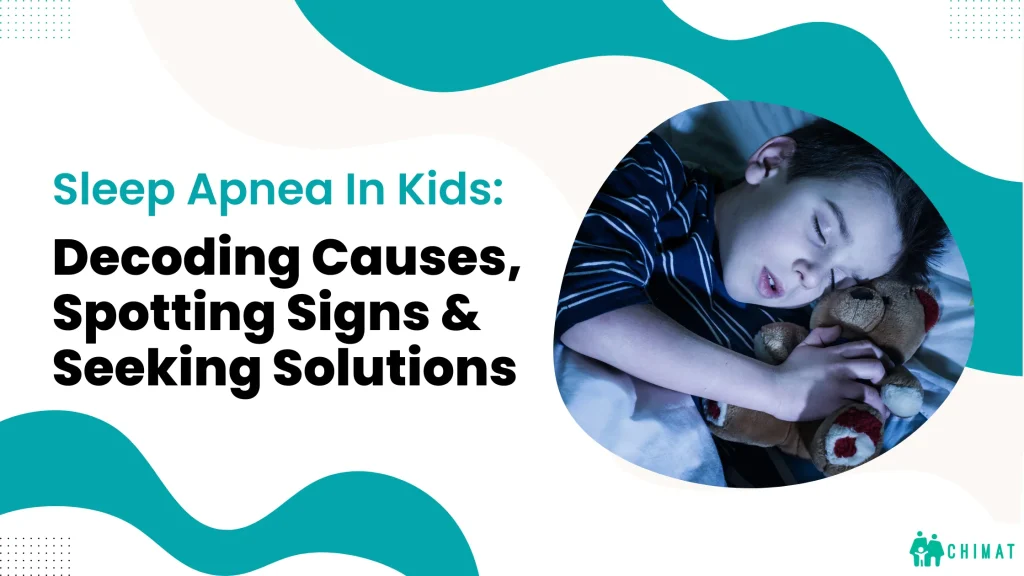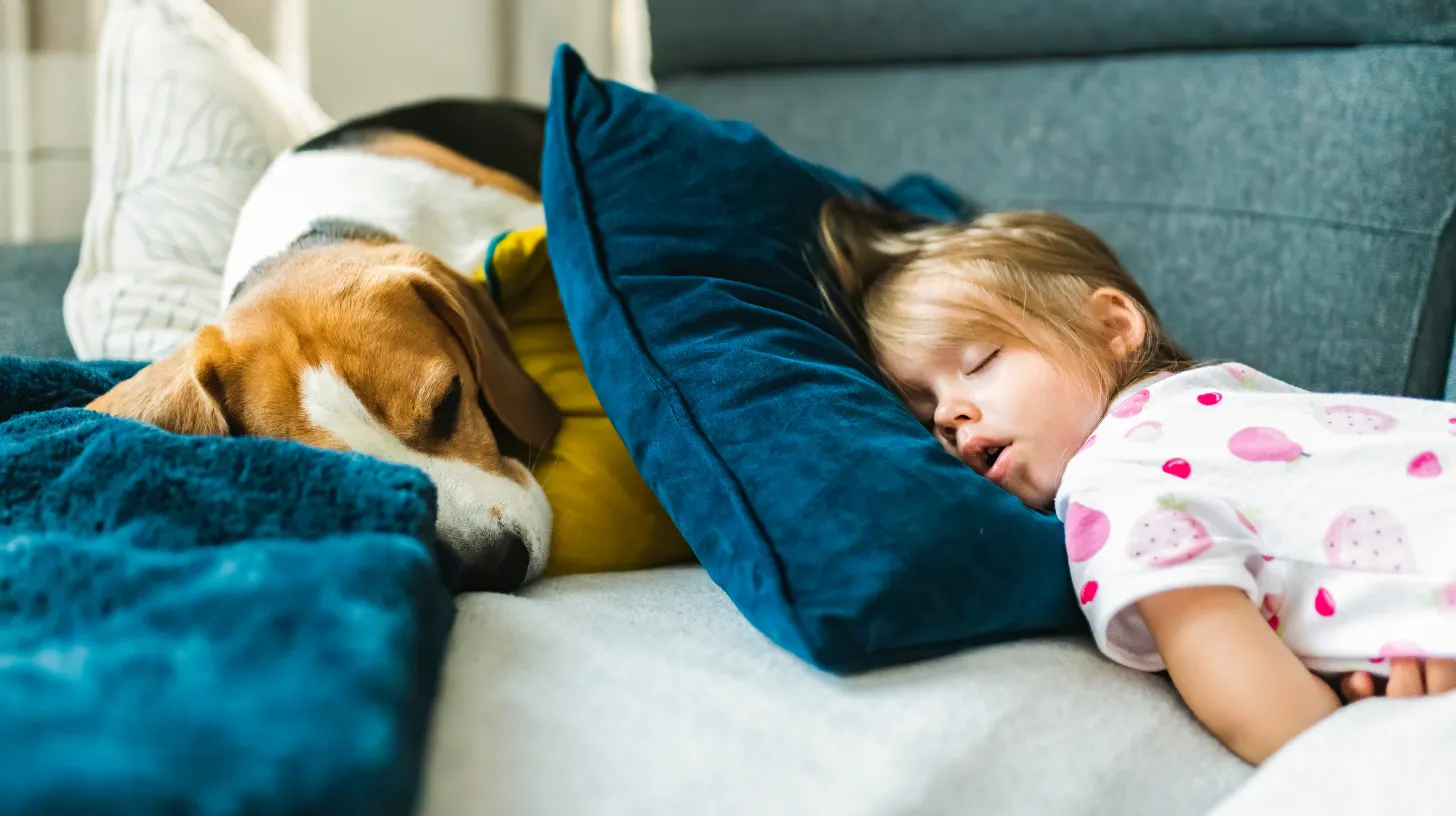Pediatric sleep apnea is a prevalent yet often overlooked condition that can significantly impact a child’s health and well-being.
This sleep disorder, which can manifest as obstructive or central sleep apnea, affects children of all ages and has various causes, symptoms, and treatment options.
We will take a deep dive into the various aspects of pediatric sleep apnea to better equip you with knowledge about its effects on your child.
Firstly, we will explore the common causes of obstructive sleep apnea in children, such as enlarged tonsils and adenoids or infections leading to swollen airways.
Next, we will discuss the telltale symptoms, including snoring, restless sleeping patterns, daytime irritability, and attention issues.
Furthermore, accurate diagnosis by healthcare providers is crucial in managing pediatric sleep apnea effectively; hence we’ll examine home-based testing devices that may be utilized during this process.
Subsequently, an overview of treatment options like removing enlarged tonsils or treating infections and Continuous Positive Airway Pressure (CPAP) therapy will be provided.
Last, but not least, it’s essential to make informed decisions when visiting your child’s healthcare provider regarding pediatric sleep apnea concerns; thus, our final section offers tips on preparing a list of symptoms and asking relevant questions about diagnosis and treatment.

Table of Contents:
- Causes of Obstructive Sleep Apnea in Children
- Symptoms of Obstructive Sleep Apnea in Children
- Diagnosing Obstructive Sleep Apnea in Children
- Treatment Options for Pediatric Obstructive Sleep Apnea
- Tips for Visiting Your Child’s Healthcare Provider
- Conclusion
Causes of Obstructive Sleep Apnea in Children
Obstructive sleep apnea is when children briefly stop breathing during sleep due to blockage in the upper airway. It commonly affects children aged 3 to 6 years old, and enlarged tonsils or adenoids are often the primary cause. Infections can also lead to swelling that blocks the airway.
Enlarged tonsils and adenoids as common causes
The most frequent reason for obstructive sleep apnea in children is enlarged tonsils and adenoids.
These lymphoid tissues at the back of your child’s throat may become excessively large, leading to partial or complete obstruction of their airways while sleeping.
When this occurs, they struggle for breath throughout the night, causing interrupted sleep patterns.
Infections leading to swollen airways
Besides enlarged tonsils and adenoids, infections such as tonsillitis or sinus infections can cause inflammation within your child’s respiratory system.
This swelling narrows their already small air passages further, making it difficult for them to breathe properly during sleep.
Episodes of respiration cessation, accompanied by frantic attempts to draw breath, may be observed in those with obstructive sleep apnea – a telltale sign.
- Risk factors: Certain factors increase your child’s likelihood of developing obstructive sleep apnea. These include obesity (which contributes to additional fat deposits around their neck), family history (genetic predisposition), allergies (leading to nasal congestion) and Down syndrome (associated with a higher risk due to physical characteristics).
- Long-term effects: If left untreated, pediatric obstructive sleep apnea can lead to various long-term health issues such as poor growth and development, behavioural problems, learning difficulties and even cardiovascular complications. Therefore, early detection and intervention are crucial.
Pediatric obstructive sleep apnea is a serious sleep disorder that can long-term affect your child’s health. If your child experiences symptoms such as daytime sleepiness, witnessed apneas, or reduced sleep efficiency, it is essential to seek medical attention.
Treatment options may include rapid maxillary expansion, myofunctional therapy, or surgery to remove enlarged tonsils or adenoids. Consult with a sleep medicine specialist or sleep clinic to determine the best course of action for your child.
Symptoms of Obstructive Sleep Apnea in Children
Obstructive sleep apnea can manifest differently in each child, but there are some common symptoms to watch out for. Recognizing these signs is crucial for early diagnosis and treatment, as they may indicate that your child is struggling with this condition.
Snoring and Restless Sleeping Patterns
Snoring is often the most noticeable symptom of obstructive sleep apnea in children. It occurs when the airway becomes partially blocked during sleep, causing vibrations in the throat tissues.
In addition to snoring, you might also observe restless sleeping patterns or frequent awakenings throughout the night. These disruptions can significantly impact your child’s sleep quality and overall well-being.
Daytime Irritability and Attention Issues
Poor-quality sleep due to obstructive sleep apnea can lead to daytime irritability, mood swings, and behavioural problems in children.
You may notice that your child seems more emotional or has difficulty controlling their temper compared to their peers without this condition.
Sleep apnea-related fatigue can also contribute to attention issues at school or difficulties concentrating on tasks at home.
- Bedwetting: Despite being toilet trained during the day, some children with obstructive sleep apnea may experience bedwetting episodes at night due to disrupted sleeping patterns.
- Morning headaches: Your child might complain about headaches upon waking up because oxygen levels drop during periods of interrupted breathing while asleep.
- Poor school performance: The cumulative effects of poor sleep quality, irritability, and attention issues can lead to a decline in academic performance for children with obstructive sleep apnea.
If your child is exhibiting any of these signs, seeking medical advice for further evaluation is essential.
Early diagnosis and treatment can help minimize the effects of obstructive sleep apnea on your child’s physical and mental health.
Remember that the symptoms mentioned above could also indicate other health conditions; therefore, seeking professional advice is crucial.
Pediatric sleep apnea can manifest differently in each child, but common symptoms include snoring, restless sleeping patterns, daytime irritability and attention issues. Bedwetting, morning headaches and poor school performance may also be indicators of the condition. It is important to consult a healthcare provider for early diagnosis and treatment to alleviate its impact on a child’s health and well-being.
Diagnosing Obstructive Sleep Apnea in Children
Obtaining an accurate diagnosis of obstructive sleep apnea is crucial, as its symptoms can resemble other health conditions.
This section will discuss the importance of consulting a healthcare provider and explore various diagnostic tools, including home-based testing devices.
Importance of Accurate Diagnosis by Healthcare Providers
If you suspect your child may have obstructive sleep apnea, it’s essential to consult with their healthcare provider.
They will assess your child’s symptoms and medical history before recommending necessary tests or referrals to specialists.
Early detection and treatment are vital in preventing potential complications such as poor school performance, behavioural issues, or even cardiovascular problems later on.
Utilizing Home-Based Testing Devices
Polysomnography (PSG), the gold standard for diagnosing obstructive sleep apnea, may be difficult to perform on uncooperative children or those too young to stay overnight in a sleep centre; thus, home-based testing devices can serve as an alternative.
However, conducting a PSG might be challenging with younger children or those who don’t cooperate easily during overnight stays at a sleep centre. In such cases, home-based testing devices could be an alternative option.
- Type III Portable Monitor: This device records data such as airflow through the nose and mouth, blood oxygen levels, and heart rate while your child sleeps at home. Although not as comprehensive as PSGs conducted in a lab setting, they still provide valuable information that can help diagnose mild-to-moderate cases of pediatric sleep apnea.
- Oximetry: An oximeter measures blood oxygen saturation levels throughout the night using a small sensor placed on your child’s finger or toe. While less accurate than a full sleep study, it can help identify potential cases of sleep apnea that require further investigation.
It’s important to note that home-based testing devices may not provide definitive results for all children. Sometimes, your child’s healthcare provider might recommend an overnight PSG at a sleep centre for a more comprehensive evaluation and diagnosis.
In addition to these diagnostic tools, your child’s healthcare provider may refer them to a sleep expert or an ear, nose, and throat (ENT) specialist for further assessment. This ensures that any underlying issues contributing to obstructive sleep apnea are identified and addressed appropriately.
To diagnose pediatric sleep apnea, it’s crucial to consult with a healthcare provider and utilize diagnostic tools such as home-based testing devices. While PSGs remain the gold standard for diagnosis, portable monitors and oximetry can provide valuable information for mild-to-moderate cases. It’s important to seek early detection and treatment from specialists to prevent potential complications later on.
Treatment Options for Pediatric Obstructive Sleep Apnea
When it comes to treating obstructive sleep apnea in children, the approach will depend on factors such as your child’s age, general health status, and the severity of the condition. The primary goal is to address any underlying causes and ensure your little one a good night’s sleep.
Removing Enlarged Tonsils or Treating Infections
In many cases, enlarged tonsils or adenoids block the airway during sleep. If an obstructed airway is the source of your child’s sleep apnea, their medical provider may suggest a tonsillectomy or adenoidectomy to remove these tissues.
This procedure has been proven effective in resolving pediatric obstructive sleep apnea caused by enlarged tonsils and adenoids.
If an infection is causing swelling that blocks the airway, appropriate antibiotic treatment may help alleviate symptoms. Following your healthcare provider’s recommendations regarding medication usage and duration is essential.
Continuous Positive Airway Pressure (CPAP) Therapy
Continuous positive airway pressure (CPAP) therapy can also treat pediatric obstructive sleep apnea. CPAP machines deliver a continuous flow of pressurized air through a mask worn over the nose or mouth while sleeping.
This helps keep the upper airways open throughout slumber so that breathing remains uninterrupted.
Although CPAP therapy can be highly effective in managing pediatric obstructive sleep apnea symptoms, some children might find tolerating masks during bedtime challenging.
In such cases, healthcare providers may recommend alternative treatments or work closely with families to find the most suitable solution.
Additional Treatment Options
Besides the primary treatment options mentioned above, some additional approaches can be considered in managing pediatric obstructive sleep apnea.
These include:
- Establishing a consistent bedtime routine and maintaining a conducive sleep environment for your child.
- Encouraging weight loss if obesity is identified as a contributing factor to your child’s sleep apnea.
- Treating any underlying medical conditions that might exacerbate symptoms of obstructive sleep apnea, such as allergies or asthma.
It is crucial to consult with your child’s healthcare provider about the most appropriate treatment plan tailored specifically to their needs.
Kids with obstructive sleep apnea can experience peaceful nights and better overall health with the right diagnosis and intervention.
To treat pediatric obstructive sleep apnea, healthcare providers may recommend removing enlarged tonsils or adenoids, treating infections with antibiotics, or using CPAP therapy. Establishing a consistent bedtime routine and maintaining a conducive sleep environment can also help manage symptoms. It is important to consult with your child’s healthcare provider for the most appropriate treatment plan tailored specifically to their needs.
Tips for Visiting Your Child’s Healthcare Provider
When you suspect your child may have pediatric obstructive sleep apnea, it is crucial to consult with a healthcare provider. To make the most of your visit and ensure effective communication, follow these tips:
Preparing a List of Symptoms and Concerns
Before your appointment, take note of any symptoms or concerns you have observed in your child. This can include snoring patterns, restless sleeping habits, daytime irritability, or attention issues.
This readily available information will help the healthcare provider understand the situation better and provide an accurate diagnosis.
Asking Relevant Questions about Diagnosis and Treatment
To make informed decisions regarding your child’s healthcare plan, asking pertinent questions during the consultation is essential.
Some examples include:
- What tests are necessary for diagnosing obstructive sleep apnea in children?
- If my child has enlarged tonsils or adenoids causing their sleep apnea, what are our options for treatment?
- In case continuous positive airway pressure (CPAP) therapy is recommended, how does it work? What should we expect from using this device at home?
- Are there any lifestyle changes that could improve my child’s condition, such as weight loss if they suffer from childhood obesity or treatment for allergic rhinitis?
- If medications are prescribed as part of treatment, what side effects might they cause? Are there alternatives if those don’t suit my child well?
Pediatric obstructive sleep apnea is a serious sleep disorder that can lead to daytime sleepiness, decreased sleep efficiency, and other health problems.
If your child is experiencing witnessed apneas, mouth breathing or has underlying conditions such as cerebral palsy or developmental delay, it is important to seek medical attention from a sleep medicine specialist or sleep clinic.
Additional treatment options for pediatric obstructive sleep apnea may include rapid maxillary expansion or myofunctional therapy, depending on the condition’s underlying cause.
Pediatric Sleep Apnea Final Thoughts
Parents must know the causes, symptoms, diagnosis, and treatment options for Pediatric Sleep Apnea. Enlarged tonsils and adenoids are common causes of obstructive sleep apnea in children, along with infections that lead to swollen airways.
Some common symptoms include snoring, restless sleeping patterns, daytime irritability, and attention issues.
Accurate diagnosis by healthcare providers is essential, which can be done through home-based testing devices. Treatment options include removing enlarged tonsils or treating infections, along with Continuous Positive Airway Pressure (CPAP) therapy.
If you suspect your child may have Pediatric Sleep Apnea, it’s important to visit your healthcare provider armed with a list of symptoms and concerns, as well as ask relevant questions about diagnosis and treatment.

